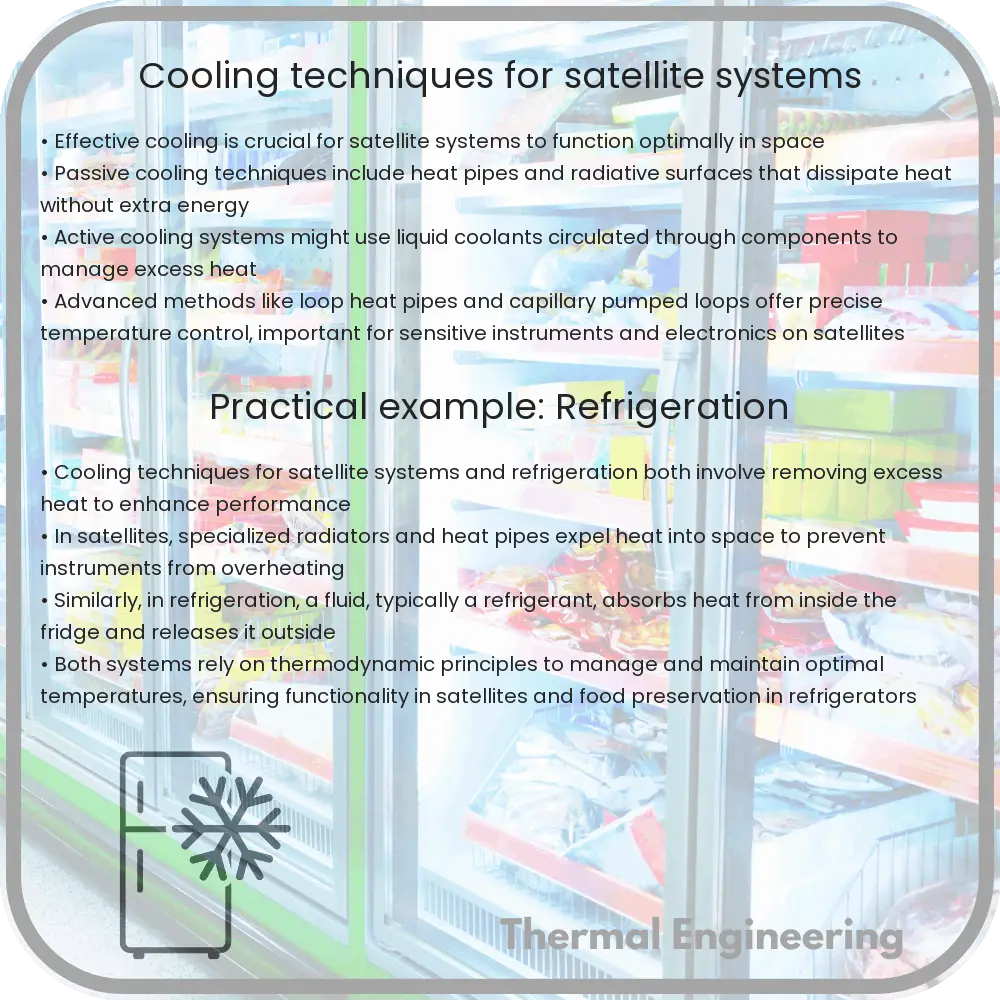Learn about essential cooling techniques for satellite systems to manage heat in space, focusing on radiative cooling, heat pipes, and active systems.

Introduction to Cooling Techniques for Satellite Systems
Satellites operate in the harsh environment of space, where extreme temperatures prevail. Managing the heat generated by onboard electronic systems and external thermal conditions is critical to the satellite’s functionality and lifespan. This article explores the fundamental cooling techniques used in satellite systems to maintain optimal operational temperatures.
Radiative Cooling
Since conduction and convection are not viable in the vacuum of space, radiative cooling becomes the primary method for heat management in satellites. This technique revolves around the principle that every body loses heat by emitting radiation. The efficiency of radiative cooling primarily depends on the emissivity of the surface, which is engineered to maximize heat emission.
- Surface Coatings: Special thermal coatings with high emissivity and low solar absorptance, such as white paints or optical solar reflectors (OSR), are applied to the exterior of satellites to enhance radiative cooling.
- Heat Radiators: Dedicated radiator panels are designed to increase the surface area available for heat emission, thus effectively cooling satellite components.
Heat Pipes
Heat pipes are a critical component in passive thermal control systems. They utilize phase change and capillary action to transfer heat from hotter portions of a satellite to cooler areas, where it can be radiated away.
- Construction: A typical heat pipe contains a working fluid inside a sealed tube with a wick structure. Heat absorbed by the fluid at the hot interface causes it to vaporize and flow towards the cooler interface, where it condenses, releasing latent heat.
- Efficiency: Heat pipes can transport heat over considerable distances with minimal temperature differences and are highly effective in temperature homogenization.
Loop Heat Pipes and Capillary Pumped Loops
Advanced versions of heat pipes, like Loop Heat Pipes (LHPs) and Capillary Pumped Loops (CPLs), are used in modern satellite systems. These devices offer greater flexibility and control over heat transport.
- Loop Heat Pipes: LHPs are similar to heat pipes but feature a looped design that can transport heat over longer distances and against gravity. They are particularly useful for satellites with large or irregular shapes.
- Capillary Pumped Loops: CPLs are more complex systems that use capillary action to pump the working fluid through a loop, effective for managing spatially separated high heat loads.
Active Thermal Control Systems
While passive cooling methods are essential, active thermal control systems (ATCS) are also employed to maintain precise temperature conditions.
- Thermal Pumps: Mechanical pumps move heat transfer fluids through closed-loop systems, capable of actively controlling the temperature of specific components or regions within the satellite.
- Electrical Heaters: Used during the cold phases of orbits or in shadowed parts of the spacecraft, electrical heaters supplement passive systems to prevent temperatures from dropping too low.
- Thermoelectric Coolers: These devices use the Peltier effect to create a thermal difference based on electrical currents, which can be precisely controlled for delicate instruments or sensors.
Conclusion
Cooling is a critical aspect of satellite engineering, ensuring that sensitive electronic systems operate effectively in the extreme conditions of space. Through a combination of radiative mechanisms, heat transfer technologies like heat pipes, and active thermal management systems, engineers are able to maintain temperatures within safe operational limits. The ongoing development in materials science and thermal management technologies continues to improve the efficiency and reliability of satellites in their crucial roles in communication, observation, and exploration.